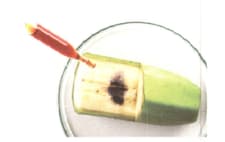Gemma Young and Mark Levesley Solutions for Exercise 27: End of chapter review
Gemma Young Science Solutions for Exercise - Gemma Young and Mark Levesley Solutions for Exercise 27: End of chapter review
Attempt the free practice questions from Exercise 27: End of chapter review with hints and solutions to strengthen your understanding. Cambridge Lower Secondary Science Stage 8 : Student's book solutions are prepared by Experienced Embibe Experts.
Questions from Gemma Young and Mark Levesley Solutions for Exercise 27: End of chapter review with Hints & Solutions
Explain why the food in your large intestine is mainly fibre.
What is the function of your large intestine?
Where in your alimentary canal is digested food absorbed into your blood?

Scientists use chemical tests to find out about the substances in things. The above figure shows the test for a nutrient on an unripe banana.
(a) Name the liquid that is being added to the banana.
(b) Describe the color change as the liquid touches the banana.
(c) What does this color change tell you about the banana?
Some tests are shown in the table. Complete the table.
| Test | What substance is being tested for? | Positive result | Negative result |
| Add Biuret solution to food | Solution to purple | Solution stays blue | |
| Rub food on a piece of paper | No greasy mark on paper | ||
| Place a glowing splint in a gas | Splint relights | ||
| Add lime water to a gas | Lime water stays clear |
A scientist uses some burning foods to heat up some water. She wants to know which food contains the most energy.

a) Which variable (shown in the table) did she control?
b)Suggest one other control variable.
c) Which food contains most energy. Explain your answer.
d) What unit is energy measured in?
Unripe apples may taste a bit like potatoes because they contain starch. As they ripen, enzymes break down the starch and the apples become sweeter. What does the enzyme break the starch into?
Explain why enzymes are catalysts.
